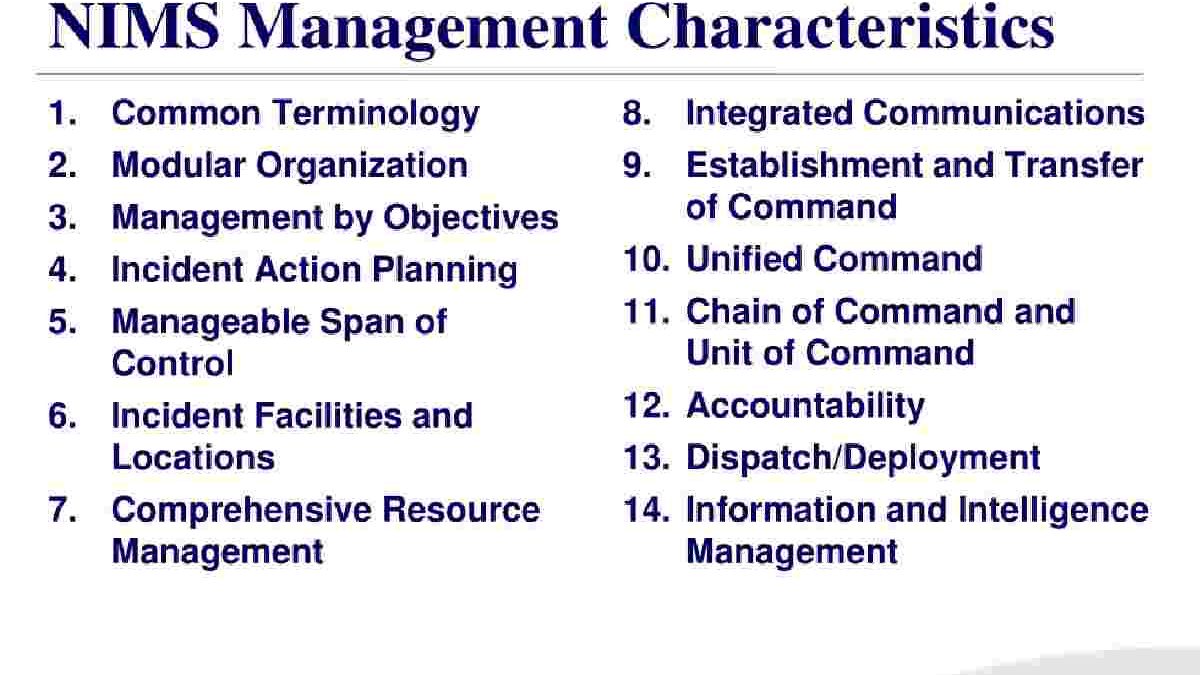Which Item Is Included In The NIMS Management Characteristic Of Accountability? – The elements included in the management responsibility characteristic of NIMS are resource tracking, personal accountability, standardized management approach of check-in/check-out method, incident action planning, etc.
Many items can be included in the NIMS Management Characteristic of Accountability. Some of these items may have: – Guaranteeing that all personnel are aware of their roles and accountabilities concerning NIMS – Putting in place procedures and protocols for reporting and documenting incidents – Establishing clear lines of communication and coordination between different agencies and departments – Conducting regular training and workouts to ensure that everyone is familiar with their roles and responsibilities – Having a clear and concise plan for incident management that is regularly reviewed and updated The Importance of Accountability in NIMS Accountability is a critical element of any emergency management system, and NIMS is no different.
Accountability helps to ensure that everyone knows their roles and responsibilities and that incidents are managed effectively and efficiently. It also helps build buoyancy and trust between agencies and departments and between the government and the public.
Table of Contents
The Importance Of The NIMS Management Characteristic Of Accountability
You must first understand the NIMS Management Characteristic of Accountability to answer this question. A technical specialist is a person who gathers, analyzes, and assesses weather service data. Surveys, data gathering, and weather observation may all be used to identify trends. By studying weather service data from technical specialists, a team can ensure that objectives are met and strategies are implemented to achieve them.
Which NIMS Management Characteristics Include Developing And Issuing?

Defining and measuring objectives is one way to manage objectives. You can achieve your goals using strategies, tactics, tasks, and activities, defining function requirements, developing plans, procedures, and protocols, and carrying out assigned tasks.
The National Infrastructure Management System (NIMS) is a situational awareness tool that federal, state, and local governments use. Using the information, we can make informed decisions that protect public safety and property. National Institute of Standards and Technology (NIMS) data forecasts and identifies hazardous weather conditions. It can also be used to forecast the damage and provide damage assessments.
The National Insurgency Management System (NIMS) is used by the Federal Emergency Management Agency (FEMA) and state and local governments to plan for and respond to emergencies. NIMS has nearly 1.4 million events in its database. This information is provided by the National Interdisciplinary Meteorological Service (NIMS). It is helpful for emergency planning and response because it aids in the protection of individuals and property.
NIMS Management Characteristic Of Accountability
There are fourteen management characteristics in the NIMS management structure.
Common Terminology is an essential component of the Incident Command System (ICS), which is based on the subsequent 14 proven NIMS management features, each of which contributes to the strength and efficiency of the entire system.
NIMS Management Characteristics
There are 14 NIMS management characteristics.
The NIMS Management Characteristics course builds on what you learned in ICS 100. Below is a list of the themes covered in the course.
- Common Terminology
- Modular Organization
- Management by Objectives
- Incident Action Planning
- Manageable Span of Control
- Incident Facilities and Locations
- Comprehensive Resource Management
- Integrated Communications
- Establishment and Transfer of Command
- Unified Command
- Chain of Command and Unity of Command
- Accountability
- Dispatch/Deployment
- Information and Intelligence Management
Objectives And Principles Of Management
With ICS becoming more complex, responsibilities may be delegated as ICS becomes larger. Incident Commanders are responsible for establishing and expanding the ICS modular organization.

Incident Commanders or Unified Commands (which will be discussed later) establish incident objectives that drive incident response activities. The objectives of Management are:
Setting specific, measurable incident objectives. Determining strategies, tactics, tasks, and activities to achieve the goals. Develop and issue assignments, plans, procedures, and protocols to accomplish identified tasks.
Documenting the results of the incident objectives.
Effective incident management is guided by incident action planning. An Incident Action Plan (IAP) captures and communicates the incident’s priorities, objectives, strategies, tactics, and assignments in both operational and support activities. The need for future timeframes (referred to as operational periods) should be addressed in the IAP.
The importance of effective accountability during incident operations cannot be overstated. To comply with agency policies and guidelines and applicable laws and regulations, you must be a part of the Incident Command System (ICS).
You should follow the following principles:
Check-in and check-out. To receive an assignment, all responders must check-in. Checking out is just as important as checking in. Incident Action Response operations must be coordinated according to the Incident Action Plan.
Each individual will have only one supervisor. The goal of personal ICS is for each individual to take ownership of their actions.
A resource management system should be established to dispatch resources only when requested or transmitted by an appropriate authority. Resources not requested should refrain from self-dispatching to avoid overburdening the incident command. An essential feature of ICS is managing resources to adjust to changing conditions.
The Incident Command System (ICS) relies heavily on information and intelligence. Information and intelligence related to incidents must be gathered, analyzed, assessed, shared, and managed. NIMS defines intelligence exclusively as threat-related information collected by law enforcement, medical surveillance, and other investigative agencies.

